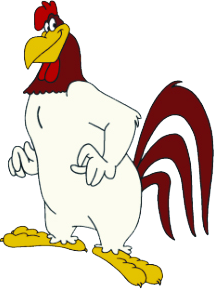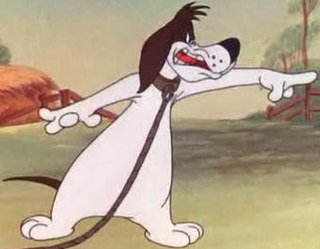Related Research Articles

Bugs Bunny is a fictional character created in the late 1930s at Warner Bros. Cartoons and voiced originally by Mel Blanc. Bugs is best known for his featured roles in the Looney Tunes and Merrie Melodies series of animated short films, produced by Warner Bros. Earlier iterations of the character first appeared in Ben Hardaway's Porky's Hare Hunt (1938) and subsequent shorts before Bugs's definitive characterization debuted in Tex Avery's A Wild Hare (1940). Bob Givens, Chuck Jones, and Robert McKimson are credited for defining Bugs's design.

Looney Tunes is an American animated franchise produced and distributed by Warner Bros. It began as a series of short films that originally ran from 1930 to 1969, concurrently with its partner series Merrie Melodies, during the golden age of American animation. Following a revival in the late 1970s, new shorts were released as recently as 2014. The two series introduced a large cast of characters, including Bugs Bunny, Daffy Duck, and Porky Pig. The term Looney Tunes has since been expanded to also refer to the characters themselves.

Daffy Duck is a fictional character created by animators Tex Avery and Bob Clampett for Leon Schlesinger Productions. Styled as an anthropomorphic black duck, he has appeared in cartoon series such as Looney Tunes and Merrie Melodies, in which he is usually depicted as a foil for either Bugs Bunny, Porky Pig or Speedy Gonzales. He was one of the first of the new "screwball" characters that emerged in the late 1930s to replace traditional everyman characters who were more popular earlier in the decade, such as Mickey Mouse, Porky Pig, and Popeye.

Speedy Gonzales is an animated cartoon character in the Warner Bros. Looney Tunes and Merrie Melodies series of cartoons. He is portrayed as "The Fastest Mouse in all Mexico" with his major traits being the ability to run extremely fast, being quick-witted and heroic while speaking with an exaggerated Mexican accent. He usually wears a yellow sombrero, white shirt and trousers, and a red kerchief, similar to that of some traditional Mexican attires. To date, there have been 46 theatrical shorts made either starring or featuring the character.

Sylvester J. Pussycat Sr. is a fictional character, an anthropomorphic cat in the Looney Tunes and Merrie Melodies series of cartoons. Most of his appearances have him often chasing Tweety Bird, Speedy Gonzales, or Hippety Hopper. He appeared in 103 cartoons in the golden age of American animation, lagging only behind superstars Bugs Bunny, Porky Pig, and Daffy Duck. Three of his cartoons won Academy Awards, the most for any starring a Looney Tunes character: they are Tweetie Pie, Speedy Gonzales, and Birds Anonymous.

The Goofy Gophers are animated cartoon characters in Warner Bros.' Looney Tunes and Merrie Melodies series of cartoons. The gophers are small and brown with tan bellies and buck teeth. They both have British accents. Unnamed in the theatrical cartoons, they were given the names Mac and Tosh in the 1960s TV show The Bugs Bunny Show. The names are a pun on the surname "Macintosh". They are characterized by an abnormally high level of politeness.
This is a list of all cartoons featuring Porky Pig. Directors are listed in parentheses.

Birth of a Notion is a 1947 Warner Bros. Looney Tunes cartoon directed by Bob Clampett and Robert McKimson. The cartoon was released on April 12, 1947, and stars Daffy Duck.

Foghorn Leghorn is a cartoon rooster who appears in Looney Tunes and Merrie Melodies cartoons and films from Warner Bros. Animation. He was created by Robert McKimson, and starred in 29 cartoons from 1946 to 1964 in the golden age of American animation. All 29 of these cartoons were directed by McKimson.
The Astroduck is a 1966 Warner Bros. Looney Tunes cartoon directed by Robert McKimson. The short was released on January 1, 1966, and stars Daffy Duck and Speedy Gonzales.
Daffy Rents is a 1966 Warner Bros. Looney Tunes cartoon directed by Robert McKimson. The short was released on March 26, 1966, and stars Daffy Duck and Speedy Gonzales.
Go Go Amigo is a 1965 Warner Bros. Merrie Melodies cartoon directed by Robert McKimson. The short was released on November 20, 1965, and stars Daffy Duck and Speedy Gonzales.
Suppressed Duck is a 1965 Warner Bros. Looney Tunes theatrical cartoon directed by Robert McKimson and written by David Detiege. The short was released on June 18, 1965, and stars Daffy Duck. It is Daffy's only solo cartoon in the DePatie–Freleng series.

Barnyard Dawg is a Looney Tunes character. A feisty anthropomorphic basset hound, he is a friend and the archenemy of Foghorn Leghorn. He was created by Robert McKimson, who also created Foghorn, and was voiced by Mel Blanc. Dawg also feuds with other enemies as well like Henery Hawk, Daffy Duck and Sylvester. He appeared in 23 Golden Age–era Warner Bros. shorts.
Well Worn Daffy is a 1965 Warner Bros. Looney Tunes animated short directed by Robert McKimson. The short was released on May 22, 1965, and stars Daffy Duck and Speedy Gonzales.
Mucho Locos is a 1966 Warner Bros. Merrie Melodies cartoon directed by Robert McKimson. The short was released on February 5, 1966, and stars Daffy Duck and Speedy Gonzales.
A-Haunting We Will Go is a 1966 Warner Bros. Looney Tunes cartoon directed by Robert McKimson. The short was released on April 16, 1966, and stars Daffy Duck, Speedy Gonzales and Witch Hazel. As with the other Witch Hazel cartoons, June Foray voices Witch Hazel while Mel Blanc voices Speedy Gonzales, Daffy Duck, and Daffy's nephew.
References
- ↑ Beck, Jerry; Friedwald, Will (1989). Looney Tunes and Merrie Melodies: A Complete Illustrated Guide to the Warner Bros. Cartoons. Henry Holt and Co. p. 353. ISBN 0-8050-0894-2.
- ↑ Lenburg, Jeff (1999). The Encyclopedia of Animated Cartoons. Checkmark Books. pp. 60–62. ISBN 0-8160-3831-7 . Retrieved 6 June 2020.